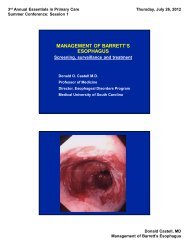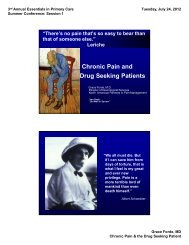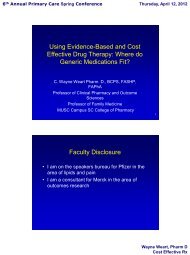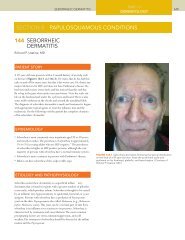New Drug Update 2010-2011 Faculty Disclaimer - CME Conferences
New Drug Update 2010-2011 Faculty Disclaimer - CME Conferences
New Drug Update 2010-2011 Faculty Disclaimer - CME Conferences
You also want an ePaper? Increase the reach of your titles
YUMPU automatically turns print PDFs into web optimized ePapers that Google loves.
2 nd Annual Essentials in Primary Care<br />
Fall Conference<br />
Friday, November 11, <strong>2011</strong><br />
Dronedarone - Multaq<br />
ANDROMEDA Study (Increased Mortality in Patients with Severe<br />
Heart Failure)<br />
• Patients recently hospitalized with symptomatic heart failure<br />
and severe left ventricular systolic dysfunction were<br />
randomized to either MULTAQ 400 mg twice daily or matching<br />
placebo, with a primary composite end point of all-cause<br />
mortality or hospitalization for heart failure.<br />
• After enrollment of 627 of 1000 planned patients (310 and<br />
317 in the dronedarone and placebo groups, respectively),<br />
and a median follow-up of 63 days, the trial was terminated<br />
because of excess mortality in the dronedarone group.<br />
Twenty-five (25) patients in the dronedarone group (8.1%)<br />
versus 12 patients in the placebo group (3.8%) had died,<br />
hazard ratio 2.13; 95% CI: 1.07 to 4.25; p=0.027. ARI 4.3%,<br />
NNH = 26.<br />
Dronedarone - Multaq<br />
BOX WARNING: HEART FAILURE<br />
• MULTAQ is contraindicated in patients with NYHA Class IV<br />
heart failure, or NYHA Class II - III heart failure with a recent<br />
decompensation requiring hospitalization or referral to a<br />
specialized heart failure clinic<br />
• Contraindications:<br />
– Second- or third-degree atrioventricular (AV) block or sick sinus<br />
syndrome (except when used in conjunction with a functioning<br />
pacemaker)<br />
– Bradycardia less than 50 bpm<br />
– Concomitant use of strong CYP 3A inhibitors, such as ketoconazole,<br />
itraconazole, voriconazole, cyclosporine, telithromycin,<br />
clarithromycin, nefazodone, and ritonavir<br />
– Concomitant use of drugs or herbal products that prolong the QT<br />
interval and might increase the risk of Torsade de Pointes, such as<br />
phenothiazine anti-psychotics, tricyclic antidepressants, certain oral<br />
macrolide antibiotics, and Class I and III antiarrhythmics<br />
Wayne Weart<br />
<strong>New</strong> <strong>Drug</strong> <strong>Update</strong> Part I









